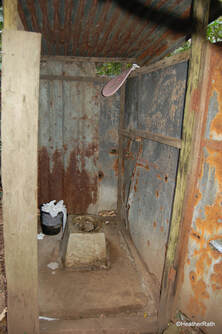
So, we’ve been living on memories. For me, that also means recalling all those dire moments when I was caught somewhere looking for someplace to answer the Call of Nature.
You’d be surprised what the world offers people like us.

The washrooms at a gas/fast food stop called Cowboys are another story. My mother judged all human beings by the state of their bathrooms. She would not have a good impression of Jefferson, Texas.
The ladies’ washroom was dark, dingy but passable. At least it had toilet tissue and soap. On the wall was a sign: No gentlemens allowed in here. This is the ladies’ washroom. If you do use the toilet, please make sure the seat is up.
In the men’s washroom my husband reported a sign also. Please close the door. We don’t want a show! The gents’ door opened into the kitchen of the Subway franchise.

We loved our second floor apartamento in this typical Mexicano casa. This is also where we learned why Norte Americanos are considered anal about bathrooms.
Our turquoise and white tiled tiny baño was, well, tiny. It looked like a leftover thought. We had to step up into this small room to use the toilet. A tiny window looked out on scarlet bougainvillea blossoms that you could see while standing in the small shower stall.
The toilet was fine. But it was the handwritten sign in English beside the toilet I remember: Please do not throw papers into the toilet. Please throw them in the wastebasket.
We lived in a no-flush tissue zone. The status quo for most of the Yucatán Peninsula --- in fact much of Central America --- where antiquated/non-existent sewage systems are the norm.

After four-and-one-half hours of non-stop driving up, up, and just over the mountains, our driver stopped for breakfast and a washroom break. His choice of restaurant and washroom facilities matched his penchant for driving. Terrible. We were parked on a small projection of land that leaned over a long drop.
The washroom facilities, if that’s what you could call them, were uniquely inadequate and not so clean. Wooden buildings sat on the edge of the outcropping and hid two seatless and stained toilets (no surprise), one for each sex. Flushing was pouring a pail of water into the toilet.
Let’s not guess where the flushed contents go.

We hired a guide and took a day trip to an indigenous area outside Esteli called Miraflor. After a two-hour bus ride (30km, 18.6mi) over an almost impassable rocky road that began in darkness at 5:30 am, I thought it best to take a bathroom break before beginning our hike at 1400m (4600ft).
It was impossible to describe the filth and inadequate facility. I took a photo of the toilet area instead (see accompanying picture). It was the only baño I’d encounter on the hike. In this area many homes are without running water.

Waiting for a flight to Thailand, and not feeling especially well, I thought it best to visit the washroom before we embarked.
Airport washrooms generally get two thumbs up.
I suppose if I’d chosen the right cubicle --- i.e. the one with the western-style toilet --- it would have been okay. However, a crowd of waiting, impatient women forced me to take the first available cubicle.
Damn! It was a squat toilet. I should have backed out but it was too late.
Now I know why so many Southeast Asian women wear the long skirted kebaya or sarong.
Try using a squat toilet when you wear jeans.
Finally, we arrived at our top-rated hotel. ‘Top-rated’ because each room has an attached mandi (bathroom), a frivolous detail I insist we include when finding accommodation in a jungle town. After a one-hour flight from the mainland, bumpy roads, and a broken-down taxi, I am desperately in need of a mandi.
Bursting into the room, all looks fine: the usual accoutrements, bed, windows, wardrobe, mirror. But where’s the mandi? I spy a door on the far side of the room, race across the bare floor, thrust open the door. Suddenly I stop.
To get to where I want to go, I must first manoeuvre down a few steps to a lower room. Too bad for me, the odour from this area is most foul: sewage mixed with heat, humidity, mildew, tropical rot.

Public washrooms should be avoided at all costs. While in China, I learned washrooms were dismal. But in Lhasa, I almost endured the worst.
I was forewarned, though, by a piece in Lonely Planet, our go-to bible during those early days of budget travel. Suffice it to know, toilets were of the squat variety. The standard model is a deep hole in the ground from which rise noxious odours.
Before entering the public toilet shack, know your doors. A reader reported that she entered through the wrong door. It was quite dark and she could also see it was very dirty. She also thought she was on a floor but had to take a step down to the squat toilet. Terrible mistake. She fell into a vat of excrement.
At least I didn’t take that near fatal step. But I did come away from Lhasa with a bladder infection.
There’s no place like home. And there’s no toilet like your own.
Strategies for women travellers using squat toilets - click here
 RSS Feed
RSS Feed